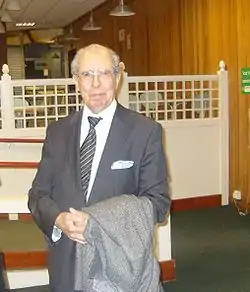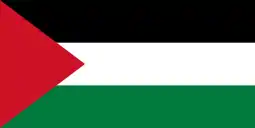Salman Abu Sitta
Salman Abu Sitta (Arabic: سلمان ابو ستة; born 1937) is a Palestinian researcher most known for his ground-breaking project mapping of Palestine in 21st, 20th and 19th centuries and developing a practical plan for implementing the Palestinian right of return of Palestinian refugees.[1][2]

| Part of a series on |
| Palestinians |
|---|
 |
| Demographics |
| Politics |
|
| Religion / religious sites |
| Culture |
| List of Palestinians |
Biography
Abu Sitta was born in 1937 into a Palestinian family with a long tradition of fierce resistance to occupiers of their land.[citation needed] Since 1922, the land had been under the jurisdiction of the British, under the provision of the British Mandate for Palestine. Prior to this, the Ottomans had ruled the region for four hundred years. Abu Sitta's family's land and the village bore their name, Ma'in Abu Sitta (the Abu Sitta springwell), in Beer Sheba District of Palestine.
One morning in April 1948, he and other schoolboys were sent home for safety reasons, after being summoned by the headmaster and told that the Jews had occupied central Palestine.[citation needed] Civil war had broken out between Palestinian Arabs and Jewish colonists fresh from Europe following the United Nations Partition Plan of 29 November 1947, which had recommended the creation of two connected States, each ruled by the majority of population in each part Arab or Jew. The Plan was a mere recommendation, it was not legally binding. The Palestinian Arab refused to give away 55% of their country to new Jewish settlers who arrived from Europe in smugglers ship. But the settlers had an organized army far superior in numbers and arms more the Palestinian defenders.
Fighting intensified in the centre of Mandatory Palestine in March, hence the decision of Abu Sitta's headmaster. Abu Sitta made the 40 km journey from Beer Sheba town back to his home on foot, and joined his family.
Before the declaration of the State of Israel on 14 May 1948, while the British were still in Palestine. the Haganah forces under Plan Dalet started a campaign to occupy large parts of Palestine. They depopulated 220 Palestinian cities and villages making up half the refugees today. Abu Sitta's Al Ma'in was attacked and houses were demolished and burnt. On the day Israel was declared, Abu Sitta became a refugee. In the following day, forces from the neighbouring Arab states, Egypt, Transjordan, Syria and Iraq tried to save the Palestinians from expulsion and massacres but failed. 247 villages in Southern Palestine including Al Ma'in were expelled and found refuge in the tiny Gaza Strip.
The Egyptian force, the largest among the Arab armies, came to defend the Palestinians in southern Palestine south of a line from Isdud to Jerusalem where 300,000 Palestinians lived and where a dozen scattered Zionist colonies where planted after WWII. The Egyptians were defeated and the whole southern Palestine was depopulated. All villages and town whose home was southern Palestine (50%) were pushed to Gaza Strip (1.3%). Today Gaza Strip concentration camp has the highest density in the world. Abu Sitta are among them.
With the Armistice Agreement of 24 February 1949, Abu Sitta's family remained refugees in Gaza Strip. Abu Sitta then moved to the prestigious al-Saidiya secondary school in Cairo, Egypt, where he graduated with "excellence", ranking first in Egypt..[citation needed] After graduating from Cairo University's Faculty of Engineering in 1958, Abu Sitta went to the United Kingdom to continue his post-graduate studies, receiving his PhD in Civil Engineering from one of the well-known colleges of the University of London, UCL.
After graduating from Cairo University's Faculty of Engineering in 1958, Abu Sitta went to the United Kingdom to continue his post-graduate studies, receiving his PhD in Civil Engineering from one of the well known colleges of the University of London, UCL.
He then took positions in London, Canada and Kuwait. His key activities include:
- Member of Palestine National Council
- Researcher on refugee affairs and author of over 400 papers on the subject
- Director of international development and construction projects
- Founder and President of the Palestine Land Society (PLS)
- General coordinator of the Right of Return Congress.
Abu Sitta has engaged in debates with Israelis who profess interest in peace without the return of the refugees, including Uri Avnery and Rabbi Michael Lerner.
Documentation of the 1948 Palestinian exodus (al Nakba)[edit]
Abu Sitta has spent 40 years digging for any detail of information about or related to Palestine before, during and after al Nakba. Abu Sitta's work has encompassed not only documenting the Nakba in which an estimated 6-800,000 Palestinians were displaced in 1948, but also ensuring that "the memories and identity of the occupied homeland are never lost". He is regarded by Uri Avnery as perhaps 'the world's foremost expert on the Nakba'. The documentation process began when he was 22 years old, when he was studying in England.
"It sort of started from there, and it has never stopped," Abu Sitta says. "I kept collecting all and any material on every inch of my homeland."
Abu Sitta's work was to show that the return of the refugees to their homes is not only sacred to Palestinians, legal under international law but also feasible and possible without major dislocation to the existing Jewish settlers in Palestine.[citation needed] His work also includes the compendium "Atlas of Palestine 1917- 1966", (Palestine Land Society, London 2010, ISBN 978-0-9549034-2-8) and Arabi edition in 2012, also the Atlas of Palestine 1871-1877, London 2020 depicting Arab Palestine before Zionists colonization. Additionally the Return Journey Atlas (2006) which shows the depopulated Palestinian village lands the Zionist colonies which occupies them today.
Published works
- The Return Journey (2007) Palestine Land Society, ISBN 0-9549034-1-2
- Atlas of Palestine, 1917- 1966 Palestine Land Society (December 2010), ISBN 978-0-9549034-2-8
- The Palestinian Nakba 1948: The register of depopulated localities in Palestine (Occasional Return Centre studies) (1998 reprinted 2000), Palestinian Return Centre, ISBN 1-901924-10-6
- Mapping My Return, The American University in Cairo Press (May 2016), ISBN 9789774167300
Articles
- Peace Palestine Traces of Poison: Israel’s Dark History Revealed
- Geography of Occupation
- Palestine Remembered Palestine Right Of Return, Sacred, Legal, and Possible
- Jerusalemite 7 June 2007 "Atlas of Palestine 1948: Reconstructing Palestine"
Youtube
- 'Right of Return Conference, Day 1:Keynote Address 13 May 2013.
References
- Irfan, Anne (20 January 2017). "Mapping my Return: a Palestinian memoir" (PDF). British Journal of Middle Eastern Studies. 44 (2): 283–284. doi:10.1080/13530194.2016.1272216.
- Abu Sitta, Salman (14–16 July 2006). "Back to Roots". Al-Awda. Retrieved 23 February 2014. Address to 4th International Convention, San Francisco.